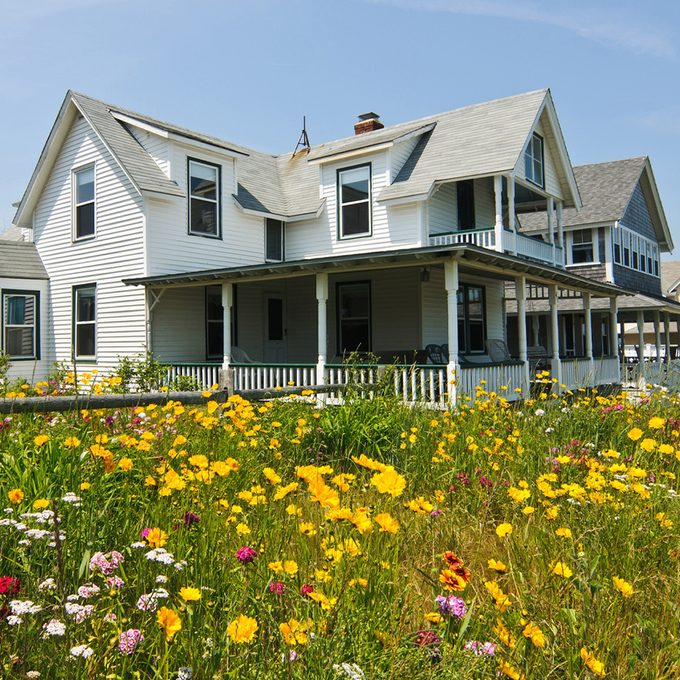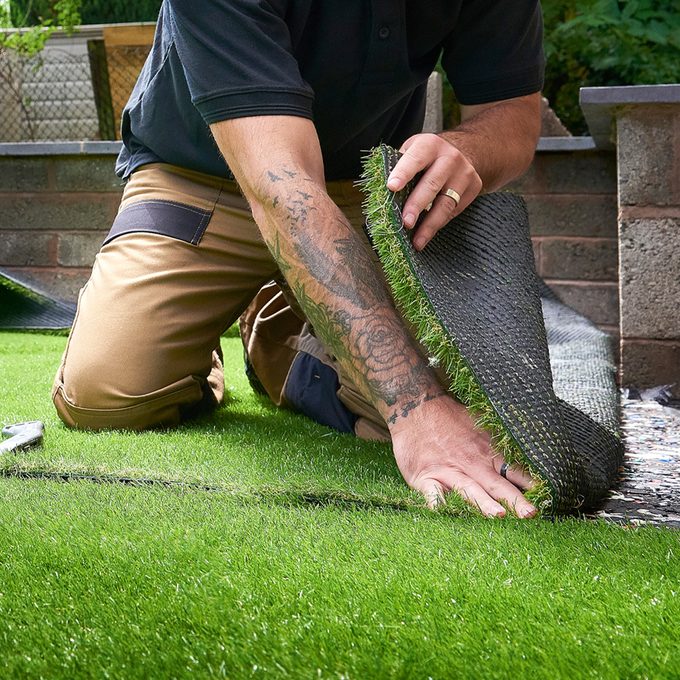Eco-Friendly Alternatives to Lawn Grass
Moving Away From Lawn Grass
In the U.S., we love our lawns. “[It’s] part of being a good neighbor and being someone who cares for your property,” says Mary Meyer, Ph.D., professor emeritus and extension specialist for the University of Minnesota.
A lush lawn makes a great play area for children and dogs. It’s invaluable for sports and games. And it’s a nice way to visually frame a house and garden. But today, some homeowners are rethinking whether a lawn is best for that space.
“Especially in the last 10 years, we see a lot more interest in the function of the lawn rather than just aesthetic appearance,” Meyer notes. “If we’re not playing soccer on it or using it for recreational purposes, why are we putting so much time and effort into a lawn?”
The lion’s share of that time and effort goes to mowing, but other things factor into lawn care. “If you want a pristine lawn, it takes a lot of maintenance and a lot of input,” Meyer says. “It’s the mower, fertilizer, irrigation, and maybe pest and weed control. Those are a lot of environmental inputs. Most of them are really negative.”
Homeowners looking for more eco-friendly alternatives have plenty of options. Here are some that require less work, water and chemicals than traditional sod.
Grasses

Low-maintenance grass, often labeled no-mow, is an option for those who wish to keep a more traditional-looking lawn. “Most mixes are a combo of four to seven fine fescues,” says Meyer. “No-mow is great. At the arboretum, we cut it maybe twice a year. It’s a good choice for areas you don’t want to cut very often.”
Prairie Nursery (prairienursery.com) is one national retailer of no-mow and native plant and seed mixes, including mixtures for erosion-prone areas.
Drought tolerant grasses are another option. Blue grama grass (Bouteloua gracilis) is a prairie bunchgrass often used as an ornamental but capable of handling lawn duties as well. Grown from seed or plugs, it needs minimal mowing, watering and fertilizing.
Buffalograss (Buchloe dactyloides) is one of the few native grasses that can be grown as turfgrass. It has less moisture and nutrient requirements than most other grasses. Zoysiagrass (Zoysia japonica) is a dense, weed-snuffing turf that’s drought tolerant. It’s a good candidate for warm regions of the country.
Pollinator-friendly grass mixes have developed a following, due in part to concern about the health of our pollinators. Fleur de Lawn, developed with the help of Oregon State University, includes ryegrass, fescue, clover, white yarrow, English daisy, sweet alyssum and baby blue eyes (Nemophila). This grass can be kept at three inches for a more manicured look, or five inches for a mini-meadow effect.
The Minnesota extension service suggests a bee lawn, which includes lower-maintenance fine fescue plus three low-growing flowering plants: white clover, self-heal (Prunella vulgaris) and thyme (Thymusserpyllum). “The fine fescues have a low nutrient requirement and a low water requirement, so it’s not high maintenance,” Meyer says.
However, Meyer says “you have to be tolerant of these forbs or flowers in your lawn. So many people who have a really pristine idea of a lawn have no tolerance for anything other than grass.”
Wildflowers

Blooming wildflower meadows are a beautiful sight, and they’re cost-efficient to install, too.
“It can be done exclusively from seed, which from a cost standpoint makes it bearable,” says Larry Weaner, of Larry Weaner Associates, an ecology-based landscape design firm in Pennsylvania featuring native species. “It is a landscape you can see around if you want to preserve open space but don’t want to mow your lawn every week.”
An established wildflower garden doesn’t need a lot of attention, Weaner says, just a weeding session once per season (spring, summer and fall) and an annual mowing at the end of winter. “That schedule is very realistic if you pick the right plants,” he says. “It’s very unrealistic if you pick the wrong plants.”
With a mix of short-lived annuals, you may eventually end up with a big patch of weeds. Instead, choose a mix that fits the conditions (sun vs. shade, moist vs. dry) and look for perennials, which will outcompete weeds once they are established in two to three years.
“It’s not about picking out the flowers that look pretty or picking out the cheapest mix, which is likely short-lived plants,” Weaner says. “This is really about understanding the environmental conditions you have and determining what are the native species to your area that grow in those environmental conditions.”
A big bonus is the meadow’s ecological impact. “Native species that occur in meadows are the most rapidly declining species of all types of native plants,” Weaner says. “Consequently, the insects and birds that depend on those particular native species are also rapidly declining.
“From a wildlife habitat standpoint, when you plant a meadow, you are planting a combination that is in part reversing the decline of two very important elements of nature: native plants and native fauna.”
More Alternatives

Artificial turf is the Jekyll and Hyde alternative: While fossil fuel is used to manufacture artificial turf, none is needed to maintain it. And while it offers no wildlife value, it does withstand heavy foot traffic and stays green during drought. Its best use may be in small spaces that are difficult to mow.
Xeriscaping, or growing plants with with less water, isn’t so much a landscape style as it is a landscape lifestyle. While the goal is to minimize irrigation, it goes beyond simply choosing drought-tolerant plants.
Some xeriscapes have plants that are not drought tolerant but instead grouped together to make watering more efficient. They’re also located strategically where soil moisture is more abundant — near a drainpipe or at the bottom of a swale. Amending the soil with compost and topping it with mulch are other water-conserving strategies of a xeriscape.
Ground covers are low-growing plants that spread by underground rhizomes to quickly cover a lot of territory. They make a fine lawn substitute as long as you’re not walking on them regularly. Most are sold in flats, so you can plant in clumps and see them fill the gaps within one or two growing seasons.
Popular ground covers include vinca vine, ajuga, lamium, dichondra, sedum and Boston ivy. There are ground covers for sun and shade, so you can grow them alone or incorporate them into a mixed shrub bed. The latter allows homeowners to test it out by replacing a portion of their lawn. You can extend an existing bed until the size and appearance meet your end goals.
If you do it right, a mixed bed can save you time down the road. The trick is to choose low-maintenance shrubs that won’t outgrow their space or need constant pruning or watering. Fill the gaps with similarly well-behaved perennials for more color. Finally, lay down landscape fabric and two to four inches of mulch to thwart weeds. Spreading a pre-emergent weed preventer helps as well.
Hardscaping includes paths, pavement and seating areas that require no watering, fertilizing or mowing. Options include laying down wood chips, pea gravel or decomposed granite, or installing permeable pavers that let water percolate back into the soil instead of running off. You can even leave planting pockets to fill with low-growing ground covers.
Getting Started
First, consider how a lawn alternative would fit your neighborhood. Bear in mind homeowner’s associations and local codes may prohibit certain types of front-yard landscaping. Also consider your neighbors.
“In your backyard, whatever pleases you and the wildlife, go after it,” says Weaner. “I would take a different approach in the front yard, where all the neighbors see it. In the front yard, it may be shorter, it may have mowed areas that define it as a planting as opposed to something that grew up because you stopped mowing your lawn.”
Prepare the area
- To turn an existing lawn into an eco-friendly one, scalp the grass, then dethatch and aerate before seeding.
- To replace a lawn with meadow, rent a sod remover, loosen the soil to a depth of three to four inches with a tiller, then rake the soil level and spread seed.
- To plant a mixed bed, mow turf short, plant in pockets, then smother surrounding area with wet cardboard topped with four inches of wood chips or similar organic mulch.
No comments